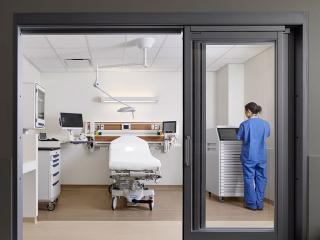With New Hospital, Stanford Will Have Separate Adult, Pediatric Emergency Departments
When the new Stanford Hospital opens, two emergency departments will begin operating: one for patients 21 and older and one patients 20 and younger.

Original article published November 14, 2017 by Stanford Medicine.
With the opening of the new Stanford Hospital on Nov. 17, the Marc and Laura Andreessen Emergency Department will have two locations: one for patients ages 21 and older and trauma patients, at 1199 Welch Road, and one for patients as old as 20, at 900 Quarry Road Extension, which is part of the original hospital.
Regardless of where they enter the hospital, patients will get the care they need, said Sam Shen, MD, MBA, associate chief quality and patient safety officer at Stanford Health Care and clinical associate professor of emergency medicine at the School of Medicine.
Adults and trauma patients
In the new hospital, an emergency department the size of a football field will serve patients 21 and older, as well as all trauma patients. Signs will direct adult patients to the entrance, on 1199 Welch Road.
Spanning nearly 43,000 square feet, the new ED was built with 66 primarily private rooms, each with enough space for multiple family members to stay at the patient’s bedside throughout care and treatment.
Contrast that with the current emergency department, where every inch of the 18,000-square-foot space, including hallways, is occupied by patients or equipment, and there’s virtually no room for loved ones.
“We have more than adequate number of physicians, and we have nurses to see patients; over the years, we have done everything you can think of to improve patient flow,” Shen said. “The issue is space.”
The patient rooms in the new ED are large enough to be split in two during high-volume periods while still providing privacy, said Vasiliy Rodin, RN, assistant patient care manager for emergency services at Stanford Health Care. In some of the rooms, the doors can break away to allow even more room for care teams.
There are also nine resuscitation areas for trauma patients, a dedicated space to keep psychiatric patients safe and video capability at each bed for teleconferences. Patients suspected of having an infectious disease can be taken to one of four isolation rooms with direct access to the outside.
In the event of a disaster with mass injuries, the lobby and psychiatric rooms were built with emergency suction equipment and medical gases, such as oxygen, inside the walls.

A rendering of a patient room in the new Stanford Hospital's emergency department
Will Pryce
“These additional wall gases will allow us to provide medical care during surge situations,” said Patrice Callagy, RN, executive director of emergency services. “We are prepared for the inevitable disaster resulting in a surge of patients needing medical care.”
“These additional wall gases will allow us to provide medical care during surge situations,” said Patrice Callagy, RN, executive director of emergency services. “We are prepared for the inevitable disaster resulting in a surge of patients needing medical care.”
Pediatric ED
The existing emergency department, at 900 Quarry Road Extension, will shift its focus entirely to younger patients — from birth through age 20.
Since 2005, Stanford has provided a separate treatment area for pediatric patients within the existing ED, staffed by board certified pediatric emergency medicine and emergency physicians, nurses and child-life specialists.
But over the past five years, patient volume in the emergency department has boomed, from the low 50,000s to about 78,000 per year — or 59,000 adults and 19,000 infants, children and adolescents. The demand for emergency services at the hospital is projected to reach 90,000 annually by the end of next year.
During the planning of the new hospital, it became clear that there wouldn’t be enough room to accommodate future growth if both populations stayed in one space, said pediatric emergency medicine director Bernard Dannenberg, MD. For many reasons, it made sense to dedicate the existing emergency department to pediatric patients, one being that it is located much closer by foot to Lucile Packard Children’s Hospital Stanford.
“All the large academic medical centers in the United States have free-standing pediatric emergency departments, because children are a special patient population that you shouldn’t be mixing with adults,” said Dannenberg, clinical professor of emergency medicine and pediatrics. “Adults have different illnesses, they respond differently, there might be a different social environment with alcohol, drugs or homelessness; children need to be in an environment that not only looks physically different, but they have to be managed by a team that just deals with children.”
Over the next 18 months, phased construction will begin to transform the emergency department on Quarry Road Extension into a modern pediatric emergency facility with triple the floor space of the existing pediatric area. It will have 15 private rooms; trauma and resuscitation areas; dedicated rooms for psychiatric patients; and a child-centered design, Dannenberg said.
The pediatric emergency department will remain open throughout the construction period.
About Stanford Medicine Children's Health
Stanford Medicine Children’s Health, with Lucile Packard Children’s Hospital Stanford at its center, is the Bay Area’s largest health care system exclusively dedicated to children and expectant mothers. Our network of care includes more than 65 locations across Northern California and more than 85 locations in the U.S. Western region. Along with Stanford Health Care and the Stanford School of Medicine, we are part of Stanford Medicine, an ecosystem harnessing the potential of biomedicine through collaborative research, education, and clinical care to improve health outcomes around the world. We are a nonprofit organization committed to supporting the community through meaningful outreach programs and services and providing necessary medical care to families, regardless of their ability to pay. Discover more at stanfordchildrens.org.
Connect with us:
Download our App: